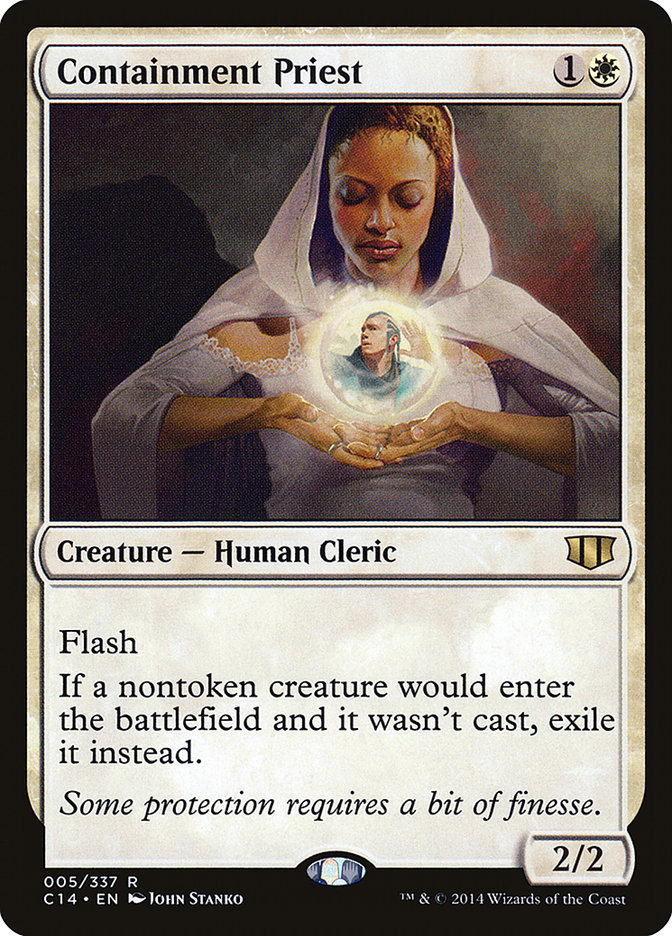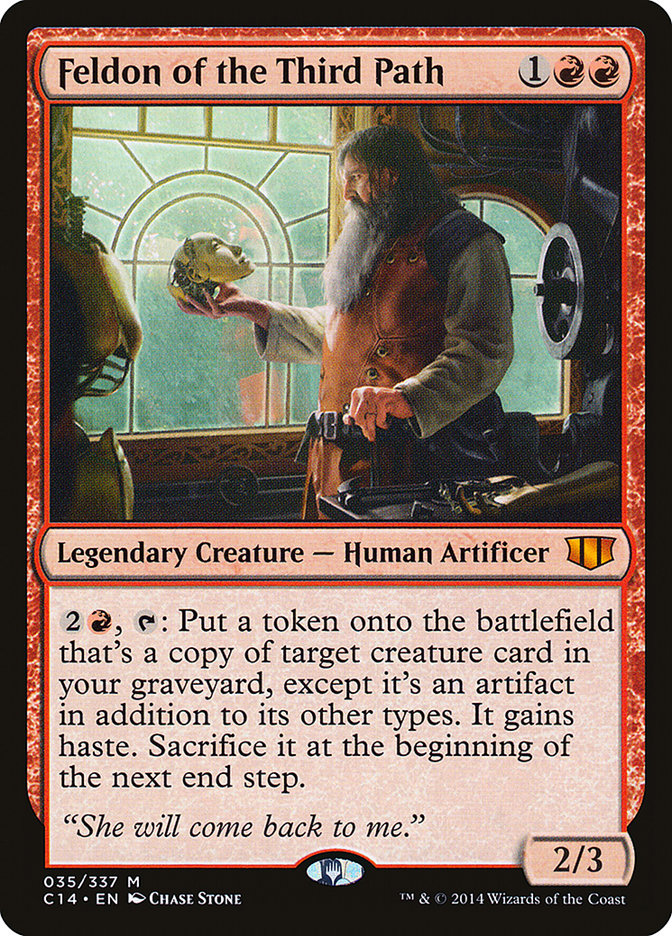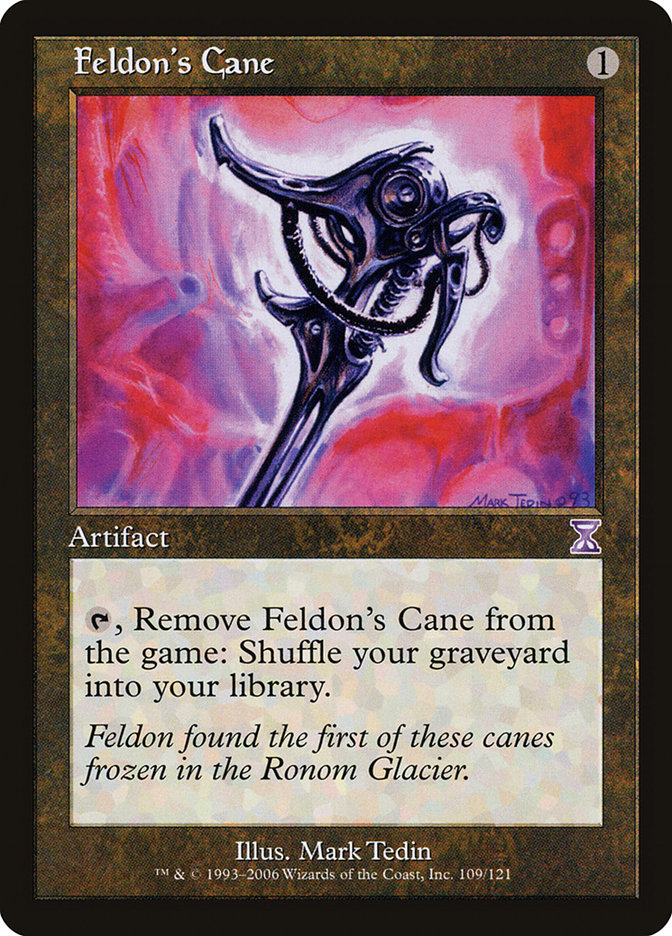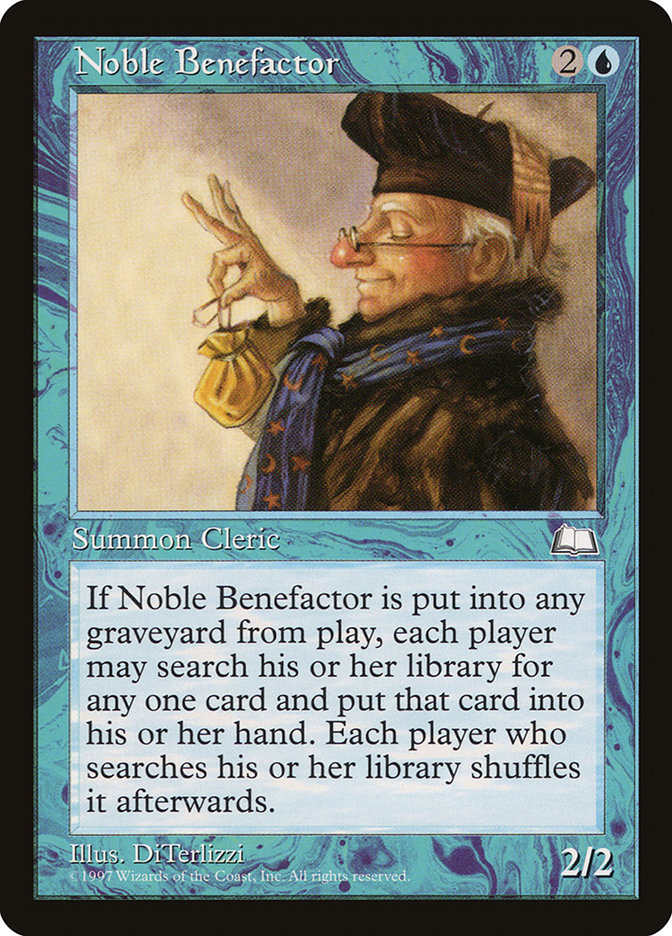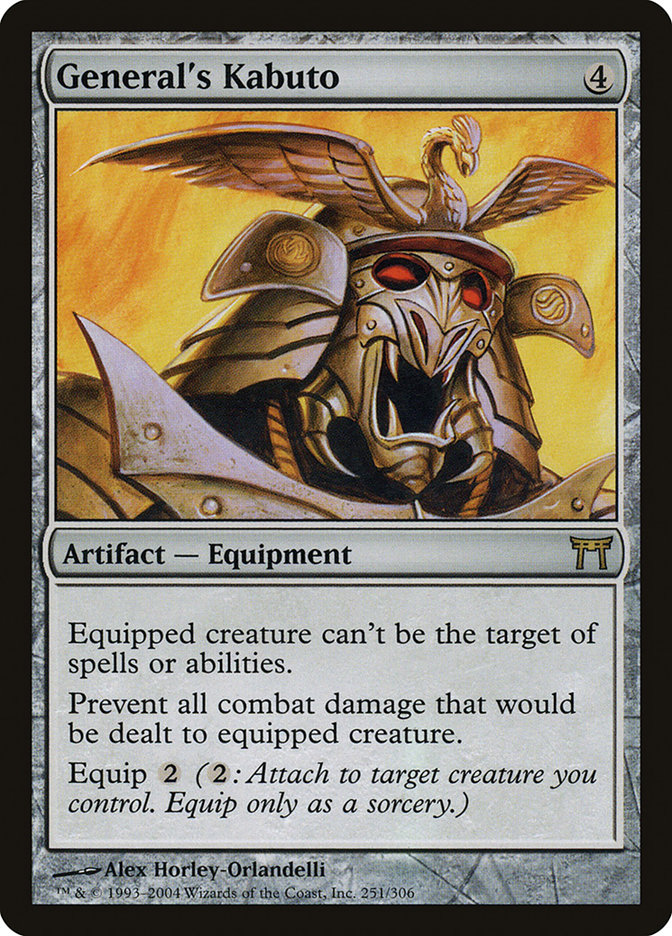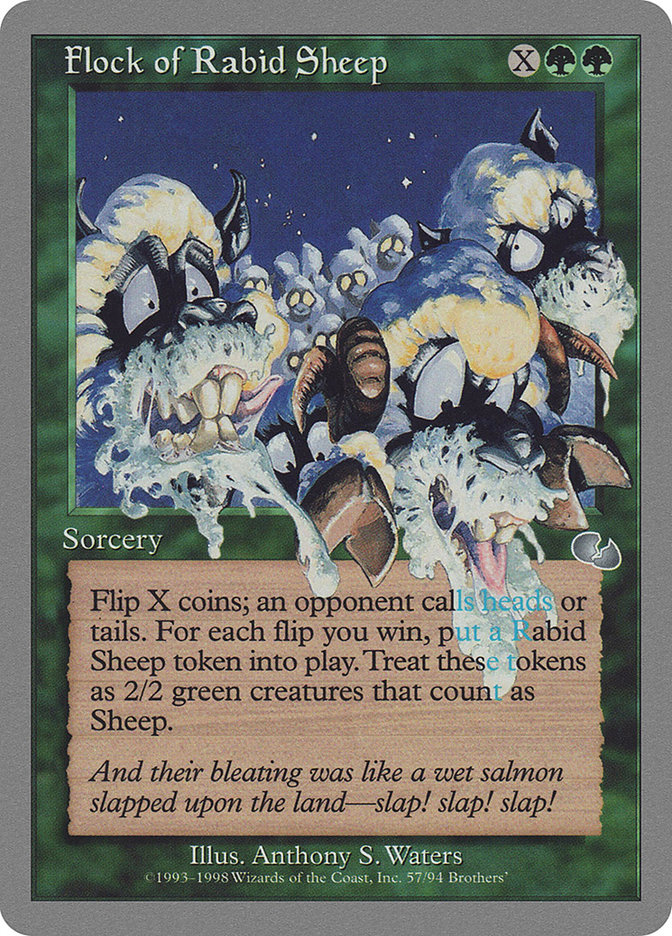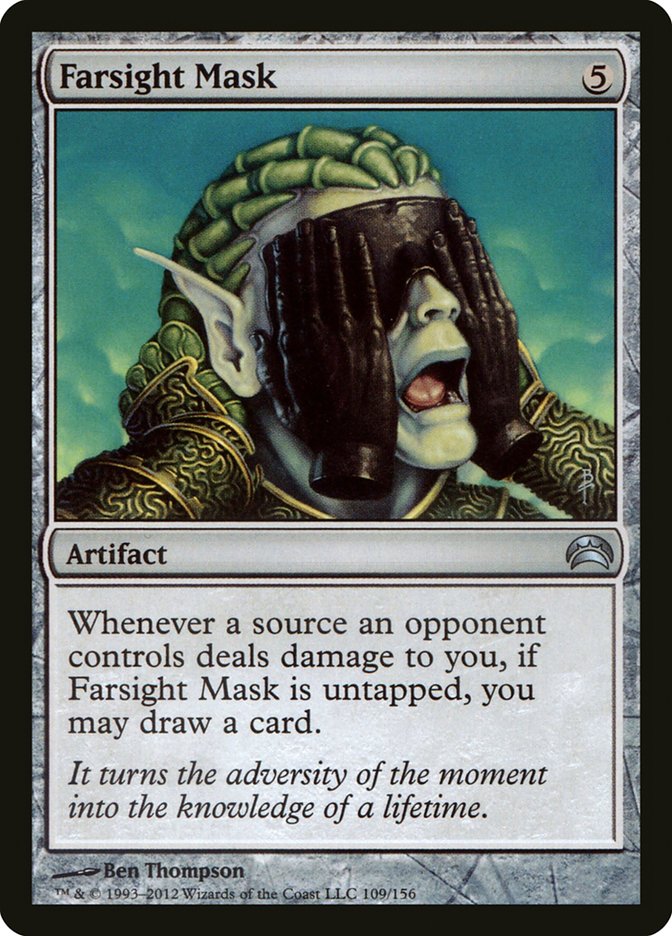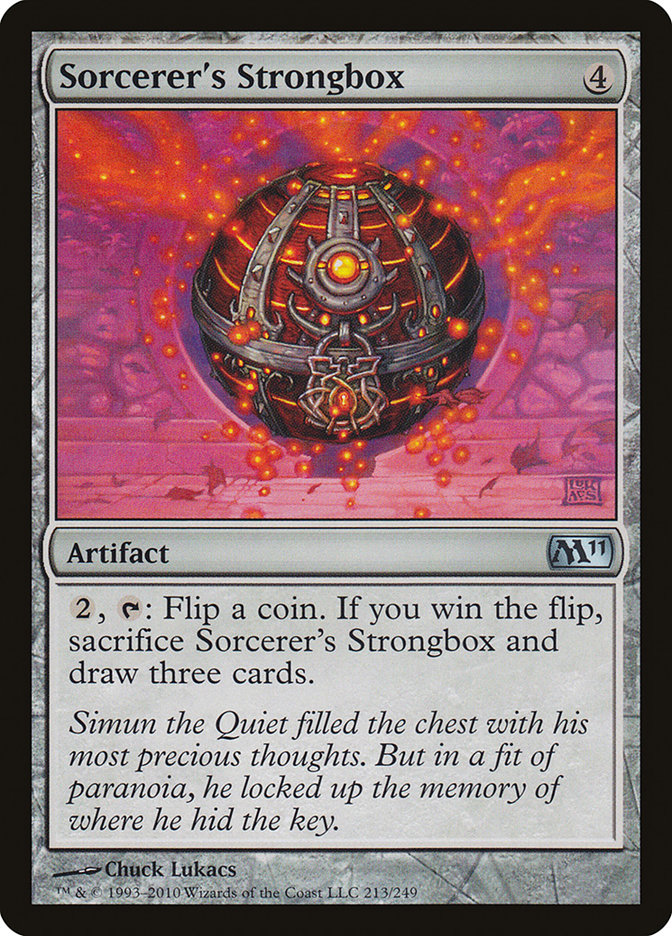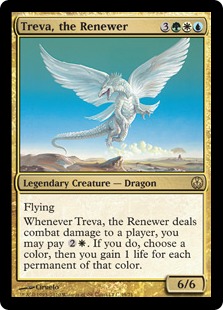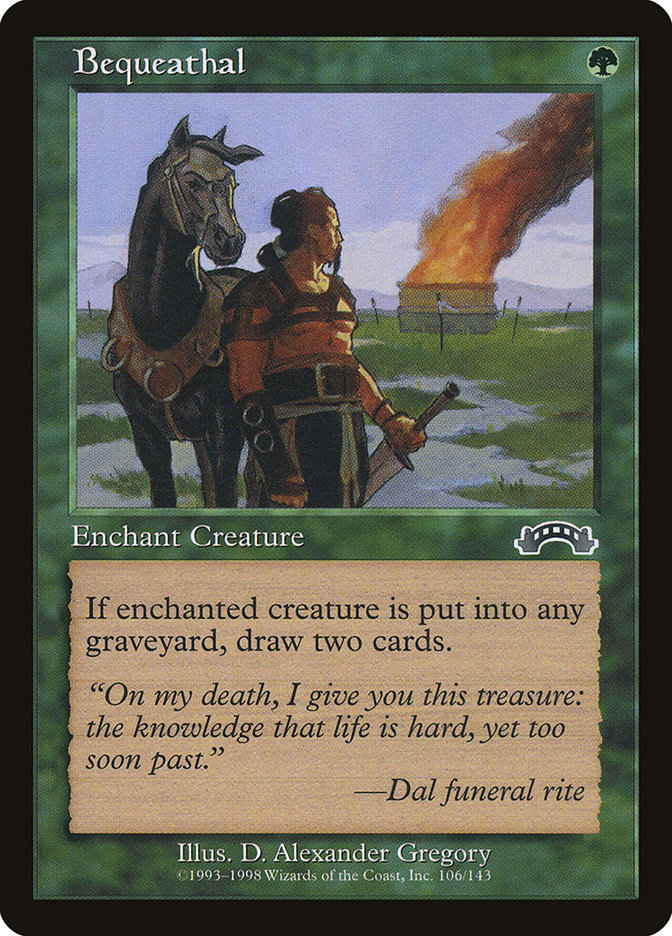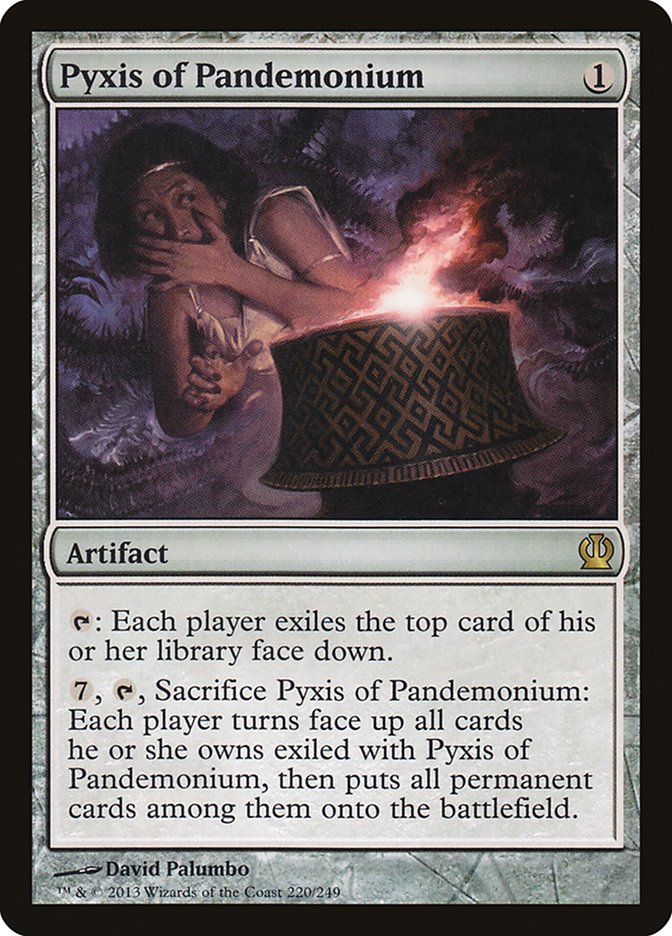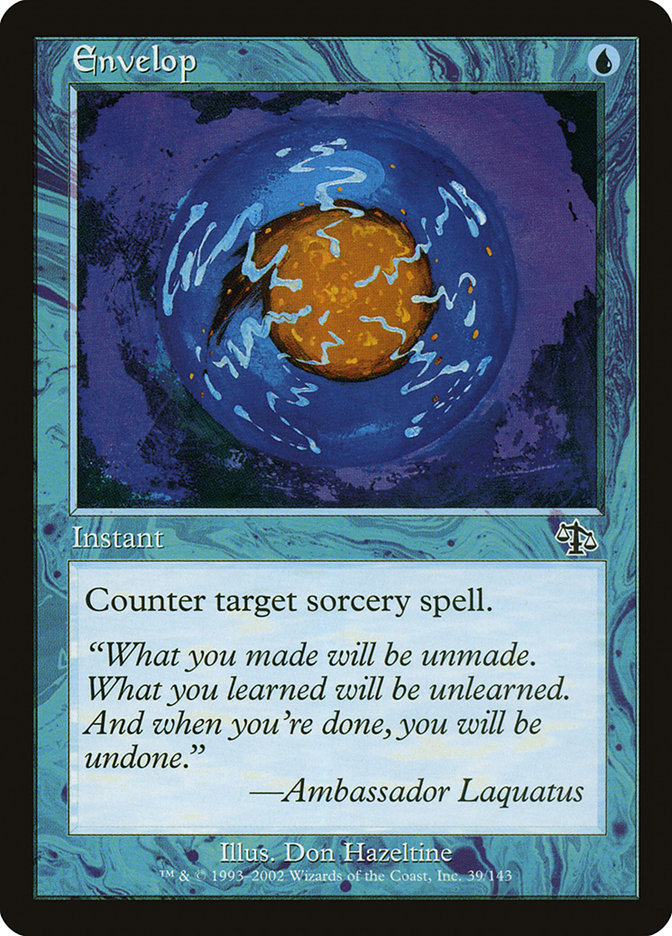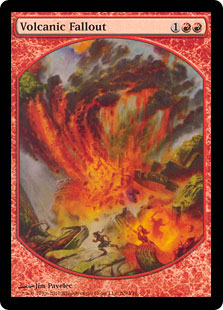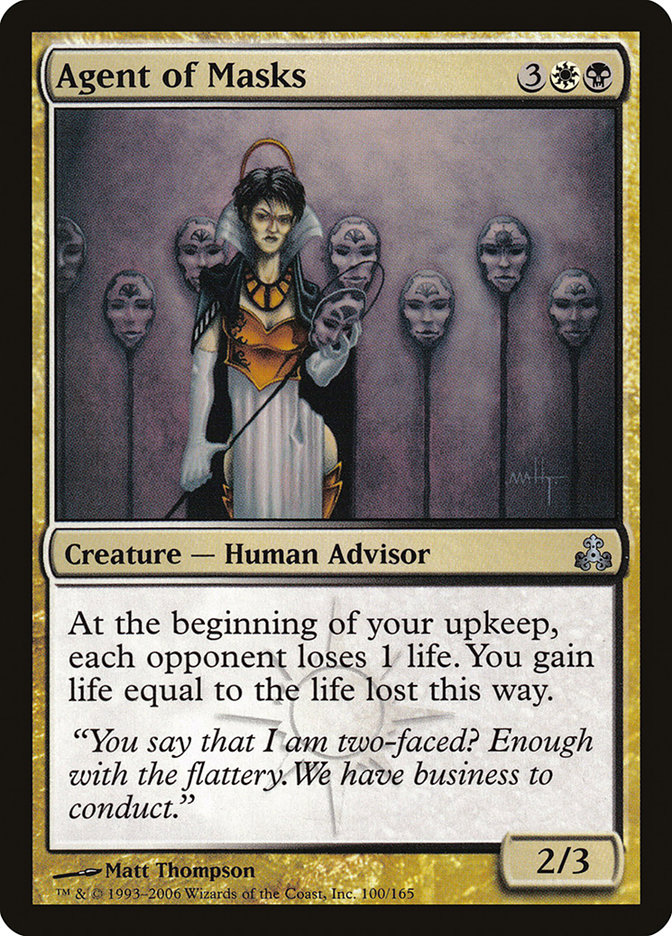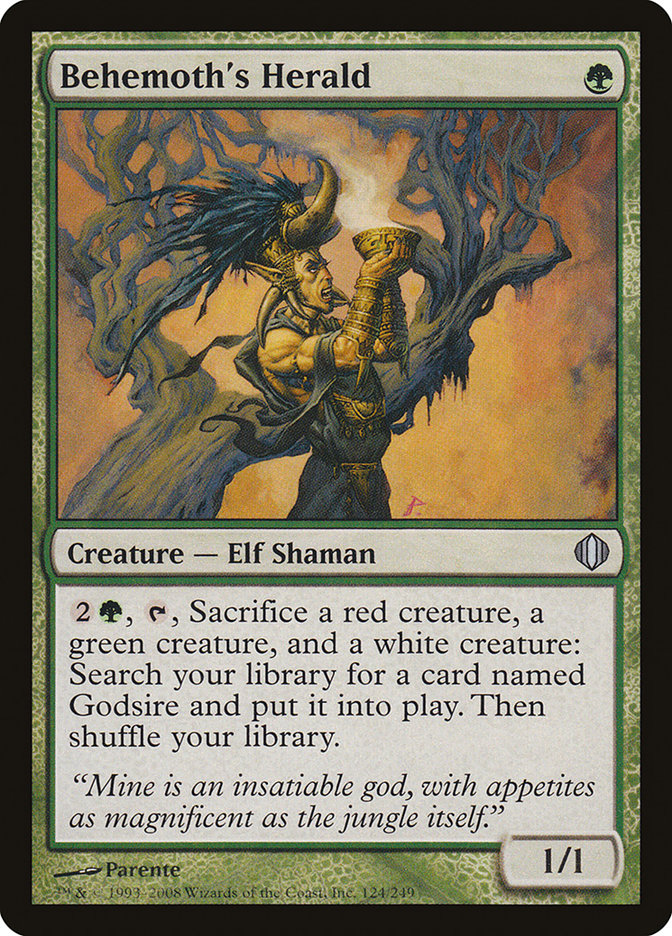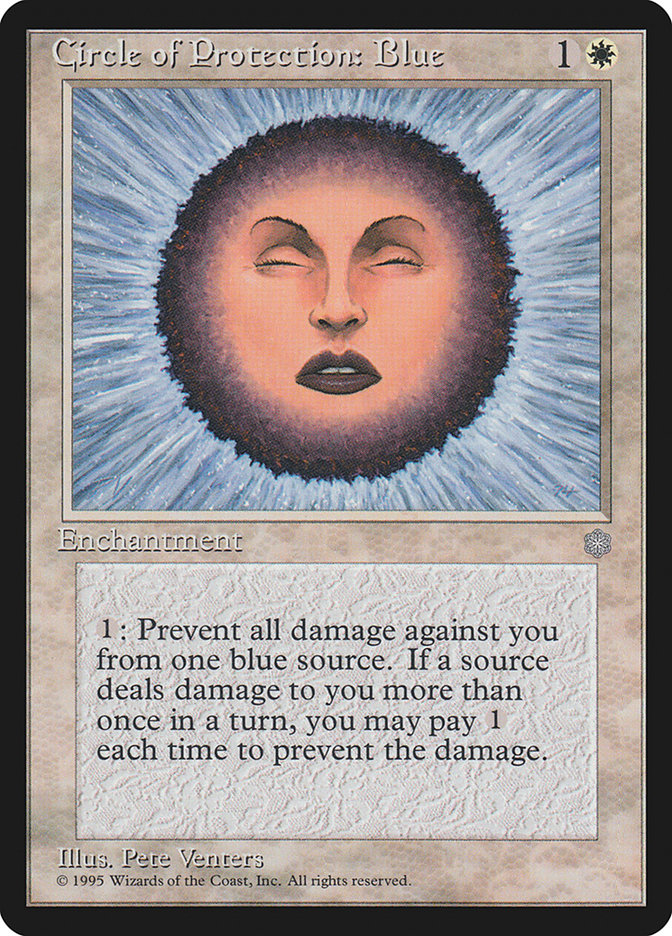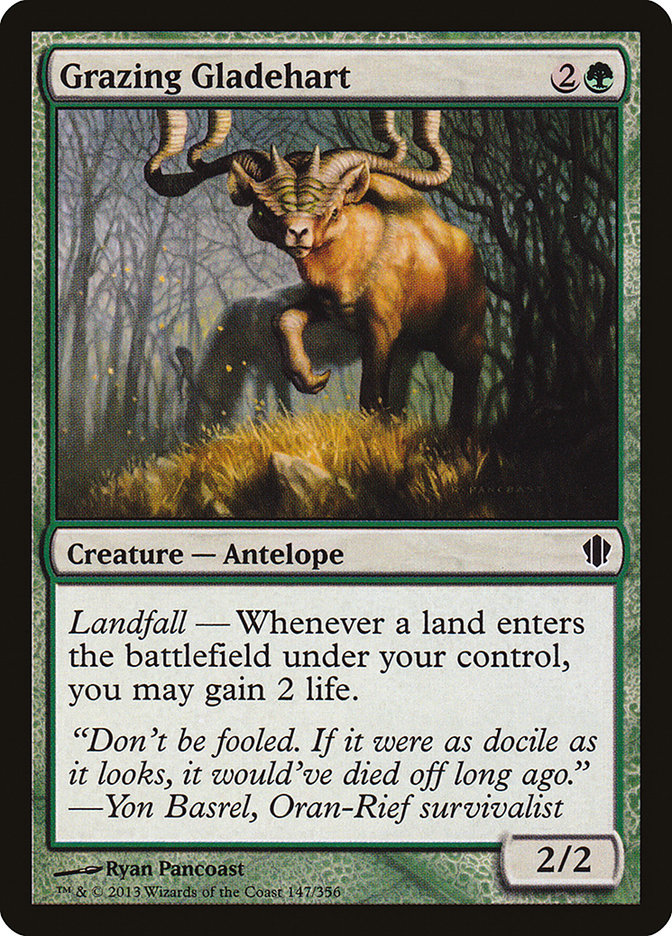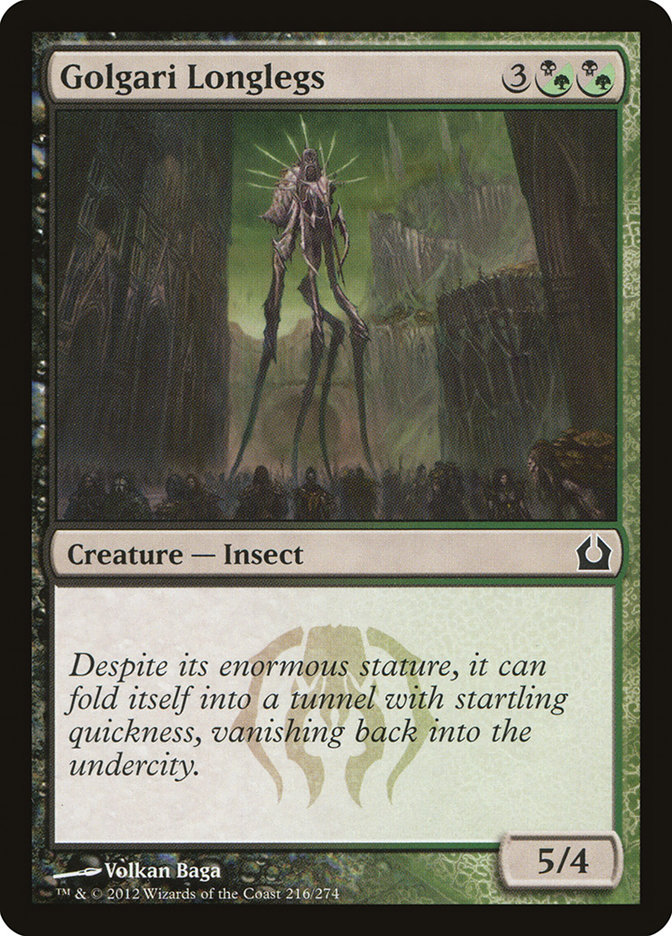Among my earlier articles for StarCityGames.com was a mini-series on collecting Magic art–you’ll kindly pardon the lack of commas–from the basics (my first-ever article as a regular columnist!) to
dipping one’s toe into original Magic illustration
to a
more specific instance of Magic art buying in action
. It’s been almost three years since I looked at the topic, however, and much has changed since then, so it’s time for a revisit.
Before that happens though, I’d like to say a few words about one Commander card a lot of folks have been talking about.
Not you. You’re good though.
In contrast with the Technicolor approach of recent Commander sets (and current product Khans of Tarkir), the recently released Commander 2014 set has a
simpler, retro vibe: one color maximum, heavy on the references to the past.
The crowning achievement, as others have noted before me,
is Feldon of the Third Path.
Feldon and how you might know him.
Feldon, an otherwise minor player in the older Magic stories who had a short story in the limelight back in a 1999 anthology, is a
testament to what Magic storytelling can do, both in old and new forms. To a newer player, the name “Feldon” might mean only as much as, say, the name
“Oloro” (as in Oloro, Ageless Ascetic of kill-his-controller-with fire) might mean to anyone else. On the other hand, it doesn’t take much
backstory to connect the graveyard simulacrum-creation, the man holding a mask-like woman’s face, and those six heartbreaking words of flavor text:
“She will come back to me.”
Someone who’s never read the short story “Loran’s Smile” might take quite a different view of Feldon from that of in-the-know Vorthoses. Has grief clouded
his judgment? Pushed him past sanity? What would he do with Loran if she ever came back to him? From the tiny amount of information on the card, there are
many possible interpretations.
As a portrait of a character though, a true rounded character with inner life, there are few rivals in the game of Magic for Feldon of the Third Path. I
consider it a milestone in through-card storytelling, and in that I am far from alone.
Also, if you want a super-quick catch-up on the broad strokes of Magic lore, you could do worse than this.
Let’s Buy Some Art!
The Magic original illustration-collecting game has changed since I started. For one thing, there’s a lot more information out there, including my previous
humble writings, the holiday art buying guides of Mike Linnemann (if you’re not following him on Twitter, fix
that ASAP), and information from other Vorthoses. If there’s one resource that’s really transformed things, I have to tip my hat to OriginalMagicArt.com, which debuted late in 2012 and has provided a nexus for discussion, showing off
collections, and sales.
More information has led to more awareness and higher prices for art. The baseline for a Magic illustration used to be $100, but in the last couple of
years it’s risen to $200 or so. Back when I was most active in buying original Magic illustrations, a period roughly from 2002 to 2012, there were real
advantages in knowing whom to talk to, how to approach artists, how to haggle, and so on. A well-placed e-mail could turn up an incredible bargain that
causes others to insult my parentage playfully, preferably with “you magnificent” in front. Nowadays the playing field is more level, the awesome deals are
all but gone, and I? Well, I am a cheapskate. A skinflint. A penny-pincher.
Pinchy pinchy!
I’m still on the hunt for true bargains, and there are still some artists who haven’t gotten with the program and listed their works online (or acquired an
agent, as Grand Prix New Jersey Guest of Honor
John Avon did with Guy Coulson), so every once in a while I can turn up a truffle, but all-in-all, the greater availability of information is bad for me and good
for you!
Before I go into the “here’s what’s out there, and here’s why I think it’s a good or bad deal” part of this article, here’s a quick refresher on my ground
rules for buying Magic illustrations:
Be polite as you bargain.
Magic art purchases happen when someone is willing to give money for art and the art’s current owner is willing to do the reverse. Get the best deal you
can, but don’t be a jerk, and if you decide to walk away from a deal, be polite about it.
Buying Magic illustrations involves individual taste and there’s no one-size-fits-all approach.
People often have specific reasons for pursuing particular artworks, such as
Invitational winners tracking down paintings with their likenesses
, that won’t apply to the general population.
Buying a Magic illustration just because it’s cheap is a sucker move.
If you can’t look at an artwork and say, “I will enjoy this,” it doesn’t belong in your collection. Take the money you would spend and apply it toward a
painting you’ll love.
Buying a Magic illustration just because I think you should is also a sucker move.
On the other hand, if I help you discover something you want, I’m glad to be held responsible.
Buying “related” illustrations can be just as enjoyable for you and a lot cheaper.
For example, while virtually the entire stock of Christopher Moeller illustrations for Magic cards has been bought out, his gallery on Fanfare has two cover paintings for the IDW Magic comics
series that might appeal to you.
On the Browse
The single best place I’ve found for browsing original Magic illustrations — at least, since StarCityGames.com sold out of its inventory — is the
aforementioned OriginalMagicArt.com. While there’s a section for sales by non-artist owners, I’ll focus on
pieces being offered by the original artists or their designated agents.
Alex Horley
– Consistently credited as “Alex Horley-Orlandelli” on Magic cards, a longtime illustrator for the game born in Italy. Prices range from $300 to $2500 and
seem mostly to do with medium (he paints mostly in acrylics on paper) and size (note that most Magic illustrations are notebook-paper-sized or smaller).
Most of Alex’s remaining works are lacking in the “sofa factor” (Original Magic Art’s term for “Can you hang this over your sofa without scaring little
children, the elderly, and your significant other?”), but one painting that I’m surprised is still available is the Kamigawa-era equipment General’s
Kabuto. It’s dramatic, it’s cool, and it’s $300. Also worth noting are his illustrated pages from the Magic webcomic series, Path of the Planeswalker.
Andrew Goldhawk
– Out of 26 paintings for Magic, just four are still listed for sale: Cremate at $300, Living Terrain at $600, and Revenant and Strength of Unity at $400.
In the absence of media or dimension in formation, and with all pieces not appealing on the Sofa Test scale, the Revenant is the best to me.
Anthony S. Waters
– Virtually all of his Magic paintings have sold, but a number of “behind the scenes” items — style guide illustrations, preparatory drawings, and so on
— are available, and for much lower prices than a finished painting, which makes them great for someone on a tight budget or just starting out. Just
remember to ask for images, dimensions, and media beforehand so you’re not disappointed! Also, his painting for the Unglued card Flock of Rabid Sheep is
still available for $600. If you were around for Unglued and loved it, I suggest fixing that situation.
Ben Thompson
– Out of 70 illustrations printed for the game, just three remain: Daru Mender, Farsight Mask, and Infest. Of the three, Farsight Mask is my favorite. Not
only is it decent-sized, it’s also pre-framed, and framing is a big expense for collecting Magic art. If you’re in more of a gambling mood, the unused
painting titled “Goblin Disco” might be worth a try (possible Unglued/Unglued 2/Unhinged art).
Chris Rahn
– He’s one of the big deals among current Magic artists, he works “large” by Magic standards (his paintings are listed at 14″ x 18″ framed), and he does
quality work in oil paint. Right now he has just three Magic illustrations listed: Abzan Battle Priest, Ainok Bond-Kin, and Mistfire Weaver. If you’re
willing to drop $1500 minimum on a painting, he’s worth a look. Personally, I like the Mistfire Weaver at $2500, though there are other things I’d rather
do with that kind of cash.
Chuck Lukacs
– The styling and stylized Chuck Lukacs hasn’t done too many Magic illustrations, with most of them in Lorwyn-Shadowmoor Block and others in supplemental
products such as the Theros hero cards and Archenemy schemes. He’s a “no set price, let’s haggle” sort with prices starting at $500. Of his remaining work,
I like the intricacy of Sorcerer’s Strongbox.
Ciruelo Cabral
– This Argentina-born artist, generally credited as just “Ciruelo” on Magic cards, has fully half his works for the game still for sale. The one that
surprises me most–and the most expensive, at $3,200, of works that start at $1,000–is the art for original Invasion dragon Treva, the Renewer. It’s a
gorgeous work, Ciruelo is most famous for his dragons, and if I had $100,000 to start dropping on original Magic illustrations, Treva would be one of my
earliest pickups.
D. Alexander Gregory
– This illustrator’s work, if put earliest-to-latest, is a microcosm of Magic’s evolving style as the abstracted, simple works such as Inner Sanctum give
way to the more “realistic” glossy effects seen on Jace, Memory Adept and other recent planeswalkers. All of his available works are older and more obscure
cards, but that doesn’t make them any less valuable, and the prices top out at $450. If I weren’t saving up for various trips, I’d give a serious think to
buying Bequeathal, available for just $350.
Daren Bader
– One of Magic’s more prolific illustrators with a lot of paintings left to sell. For a Magic art collecting hipster (and yes, I know a few people who
specialize in being off the beaten path), there’s Murgish Cemetery. It was never printed as a physical card, but it was included in a Japan-only Sega Dreamcast game called Magic: The Gathering. That’s $500.
Less expensive, at $300, is the Worldwake Plant token, which could hang over a
couch in an “oh, that’s a pretty flower wait what when did I just walk into a Lovecraft story”
kind of way. The one that really shocks me as being still available though, is the Unglued Soldier token, one of the game’s originals. It’s Magic history. It’s
$500. Wow.
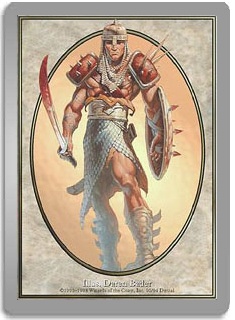
David Palumbo
– AKA the dude who did Totally Lost (and yes, that painting is Long to the Gone). Also long gone are most of his works I’d recommend, like the landscape
Stomping Ground or the striking Human Frailty. Out of what’s left, priced $500 to $950, my recommendation is the expensive but expressive Pyxis of
Pandemonium.
Don Hazeltine
– Well, there’s only one actual painting left for him. Fortunately, I can actually recommend it: for $500, it’s the abstract, narrow-but- it-actually-helped-Reid-Duke-win-an-Open sorcery-slayer Envelop.
Jeff Miracola
– The longtime Magic illustrator still has a number of paintings for sale, though the landscapes, the significantly played cards, and the beebles are gone.
Prices start at $350, and this is one of the few recommendations I’ll make that bends the “because it’s cheap” rule. If you have the right environment for
a large image of a tired student (college dorm room, perhaps?), then the sizable Fatigue painting (20″ x 16″) for just $400 might be the ticket.
Jim Pavelec
– Significant Magic illustrator and a driving force behind ArtPACT, a resource for illustration freelancers.
His available paintings start at a hefty $850, but one of them is the textless Player Rewards version of Volcanic Fallout, and that’s my recommendation.
Larry MacDougall
– Watercolor maven Larry MacDougall came onboard only for Lorwyn-Shadowmoor Block but made an impression in that short time. Of his four remaining
illustrations, all $400, I like Favor of the Mighty, though I’d understand if one’s tastes ran toward Mudbutton Clanger instead.
Matt Thompson
– Of two dozen Magic illustrations Matt Thompson has done, he’s sold only a few. Unfortunately, those are the “biggies” like Serum Powder and Disciple of
the Vault (and that bane of Affinity players everywhere, Kataki, War’s Wage). At $400, Agent of Masks is a small jewel, though Matt’s drawings are also
worth a look.
Matthew Stewart
– Mr. Stewart’s most important paintings (Narcomoeba and company) are no longer available. Of what’s left, Fanatic of Mogis is expensive at $850 but it’s
intricate, beautiful in a “metal” way, and could be made to fit in the right room. The $75 preparatory drawing for Gremlin Mine might be a good deal, but
ask for an image first.
Mike Raabe
– Tinker has sold for older-school artist Mike Raabe, but somehow Talon Sliver is still available. Yes, it carries a $1,000 price tag. No, it shouldn’t
still be available. There’s a well-heeled Sliver fan out there who wants this painting and doesn’t know it yet.
Nils Hamm
– The master of creepy elegance has only a few paintings left. If one of the five is to your taste, buy it. Unfortunately, I don’t have a good
recommendation at current exchange rates (note that the European artist Hamm has dimensions in centimeters and prices in Euros).
Paolo Parente
– Sometimes credited as “Paolo Parente” and more recently as just “Parente,” this Italian artist-designer has plenty of pieces to sell. Prices start at
$500 and my pick, Behemoth’s Herald, is at that level. If you spend much time on the Wizards website, you’ll remember it as one of their most popular
“Announcing…” backdrops.
Pete Venters
– One of the most prolific illustrators in Magic history. One of his earliest and least expensive paintings is Circle of Protection: Blue from Ice Age,
which could be part of a non-Magic interior design with a certain sensibility. Make sure to read Pete’s comments; they’re infrequent, but a hoot.
Ryan Pancoast
– A quietly brilliant illustrator and one of the nicest artists I’ve ever met in person, Pancoast is also a master of hand-drawn tokens on the backs of
artist’s proofs. While his landscapes are long gone (notice a trend?), he has other pieces remaining at prices from $500 to $2100. Pay attention to his
dimensions, because he used to paint a lot bigger than he does nowadays. At $950, I’m a fan of Grazing Gladeheart.
Scott Murphy
– A newer Magic artist, Scott Murphy has a lot of talent but not a lot of marketable images (yet). Of his four paintings for sale, one of which might have
gone unused, the humorous Meteorite at $800 is my pick.
Steve Prescott
– The prolific Steve Prescott has plenty of paintings available, as well as a number of sketches. (Ask for a picture, but that Spinerock Knoll sketch for
just $50 could be awesome!) As for the paintings itself, which start at $300, I’m highest on the most expensive one at $2200…because it’s Yule Ooze, the
2011 holiday WotC promo card!
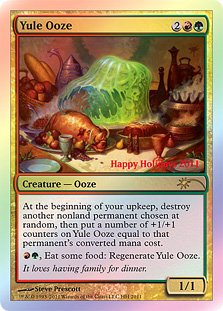
Steven Belledin
– An artist whose work I own myself, Belledin currently lives in Seattle and has only a dozen or so paintings left out of more than 100 done for the game.
While he has paintings as low as $300, I’d suggest skipping the older paintings and going for the recent mini-masterpiece, Abzan Falconer.
Tony Roberts
– British illustrator Tony Roberts was with Magic only briefly, for Mirage Block, but he made an impact, particularly with his Forest mural. Of his 500-pound art remaining,
the dazzling Windreaper Falcon is my pick.
Volkan Baga
– Volkan Baga is a gifted German artist whose best works get snapped up almost as soon as they’re offered. The paintings he still has available are almost
universally ones he did of “ugly” subjects; Abattoir Ghoul, though technically accomplished, has no “sofa factor.” Of what’s left, the eerie austere beauty
of Golgari Longlegs is my pick.
There’s a whole wide world of Magic art to explore, and while things have changed radically since I started (Facebook didn’t exist then; now there’s a
Facebook group dedicated to it called MTG Art Exchange), there are still opportunities for the folks who know where to look. Start small. Develop your
sense of what makes for good art and buy what you love, not just what others recommend. Magic art is a matter of passion, and whether you choose to collect
one special piece or go on a quest like “acquire one of each basic land for ultimate basic land bragging rights,” I wish you the best of luck on your
journey.


